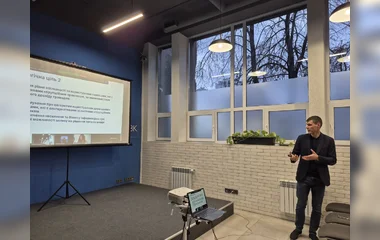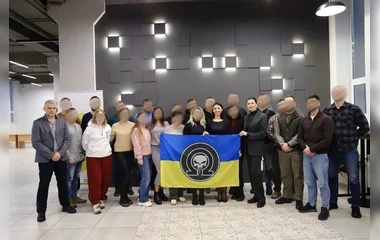On December 21, a briefing "The new NACP approach to selection and verification of tax return declarations" was held with the participation of Artem Sytnyk, Deputy Head of the National Agency on Corruption Prevention (NACP), and Yulia Kulikova, Head of the NACP's Department for Full Scrutiny.
"The NACP is changing its approach to the selection and verification of declarations. Previously, the NACP was obliged to annually verify the declarations of all top officials, so it selected declarations for full verification depending on the category of position, primarily the President of Ukraine, ministers, people's deputies, judges of the Constitutional Court of Ukraine, and the Supreme Court. More than 99% of declarations were not covered by the NACP's systemic control, and verification of other officials was possible only upon citizens' requests, journalistic investigations, or in the framework of cooperation with law enforcement agencies. As a result, we did not fulfill public expectations in terms of the verification of declarations. What has changed? From now on, the selection of declarations will be based on the results of the risk assessment of the declaration, i.e., depending on the risk rating. This became possible because the Law of Ukraine "On Prevention of Corruption ''was amended to eliminate the obligation to check all declarations of top officials annually, which made it possible to actually change the approach to selecting declarations to a risk-based verification," said Artem Sytnyk.
Over the past year and a half, when the mandatory submission of declarations and their verification was suspended, the NACP has focused on lifestyle monitoring and used this time to develop IT products that can ensure the implementation and enforcement of the new approach, as well as optimize the work of NACP authorized persons and make full verifications a more effective financial control tool.
"All submitted declarations will be subject to risk assessment, and those declarations that have the lowest risk rating and can be checked automatically will be checked using the help of software tools—an automated verification mechanism. This involves comparing the declaration data with other registers and checking it with certain "formulas," for example, to identify signs of illegal enrichment, the presence of unjustified assets, etc. Receiving a certificate of auto-verification will not mean that the declaration has been fully verified but will indicate that it has a minimal risk factor. We predict that one-third of declarations will pass this verification. The NACP will be able to return to them if new facts are discovered or if it receives an appeal about signs of false declaration. Out of the remaining 70% of declarations, those with the highest risk rating will be selected for full verification, and the selected declarations will be distributed to the NACP's authorized persons for verification in an automated mode. The possibility of human intervention in the auto-verification or auto-distribution procedures is excluded; it is done by a machine using software products that have been protected," said the NACP Deputy Head.
The declarant will be notified of the fact that the declaration has been automated verified in their personal account in the Register of Declarations starting on December 27. Declarants can find the relevant certificates in the Register of Declarations. It is worth noting that obtaining such a certificate does not give the right to submit an amended declaration, but it can be used to correctly fill out the declaration for the next period or to correct data in the registers (if they are out of date). Only declarations filed for 2021 and subsequent reporting years can be subject to automated verification (it is not possible to do so for previous years). The auto-verification process can take from a week to a month and a half.
"We have a request from declarants that the full verification procedure should not be burdensome for them. That is why the NACP has amended the procedure for conducting full audits, distinguishing between false and inaccurate information, depending on the size of the discrepancies in the declaration. Up to 100 subsistence minimums (for declarations submitted in 2023 - no more than UAH 268.4 thousand; in 2024 - UAH 302.8 thousand)- this is inaccurate information; more than 100 subsistence minimums are unreliable. We will not ask for explanations from the declarant about this inaccurate information in the declaration. At the same time, at the request of an authorized person, the declarant will be obliged to provide copies of documents confirming the accuracy of the specified information if they are not available to the NACP. The declarant still has the right to provide explanations. To simplify the procedure for filling out the declaration and avoid mistakes in it, the NACP has developed the function "Data for the Declaration" in the Register of Declarations," said Yulia Kulikova.
"The public will also see the results of auto-verifications: in the public part of the Register of Declarations, there will be a corresponding mark next to such declarations. A little later, a corresponding filter will be added, which will allow us to see the number of officials who have undergone such verification, as well as to determine in which bodies and industries there are the most such declarants," summarized Artem Sytnyk.
As a reminder, the declaration campaigns are ongoing; annual declarations for 2021–2022 must be submitted by January 31, 2024, and for 2023, by March 31, 2024, inclusive. You can submit a corrected declaration once within 30 days.
As of December 20, 2023, officials have already filed more than 1 million 50 thousand declarations for 2021 and 2022 (578.7 thousand for 2021, 471.7 thousand for 2022).
The recording of the briefing is available here.
Read more about the NACP's new approach to selecting and verifying declarations here.
Read more about the new "Data for Declaration" function to facilitate the process of filling out the declaration here.









